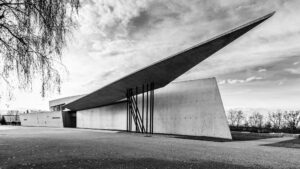Breaking boundaries as the first woman to be awarded the prestigious Pritzker Architecture Prize in 2004, Zaha Hadid is recognized as one of the most exceptional designers in history, forging a legacy of innovation and individuality. Despite Hadid’s unexpected death in 2016, her legacy continues through the projects she designed.
Born October, 1950 in Baghdad, Iraq, Hadid studied mathematics as an undergraduate and went on to enroll at the Architectural Association School of Architecture. Hadid was advised under Dutch architect, Rem Koolhaas, who would later describe Hadid as one of the most exceptional students he ever taught.After graduating, Hadid moved to Rotterdam where she worked for Koolhaas at the Office for Metropolitan Architecture (OMA). In 1980, after becoming a naturalized citizen of the United Kingdom, Hadid opened her firm, Zaha Hadid Architects, which has developed high-profile and illustrious projects around the world. Hadid and her firm introduced audiences to a new way of conceptualizing modern architecture through extremely detailed sketches rather than postmodern designs.
After graduating, Hadid moved to Rotterdam where she worked for Koolhaas at the Office for Metropolitan Architecture (OMA). In 1980, after becoming a naturalized citizen of the United Kingdom, Hadid opened her firm, Zaha Hadid Architects, which has developed high-profile and illustrious projects around the world. Hadid and her firm introduced audiences to a new way of conceptualizing modern architecture through extremely detailed sketches rather than postmodern designs.

Vitra Fire Station
The very first building complex designed by Hadid was the Vitra Fire Station, eventually launching her career. One of Hadid’s clients, Rolf Fehlbaum, the president-director of the furniture design firm, Vitra, invited her to design a fire station for his design museum. Building from 1991-1993, Hadid used raw concrete and glass that defined the sculptural building. The station, famous for the dramatic effect of its sharp diagonals converging at its center, only remained functional for a short period and now serves as an exhibit space.

National Museum of Arts of the 21st Century (MAXXI)
One of Hadid’s more recent designs, the MAXXI was built between 1998 and 2010. The structure appears to be moving and flowing through space in spots, animated by Hadid’s ambition to create movement through the design. Hadid achieved this movement through curving, white walls and the placement of the building extending precariously out over five, thin pylons. Hadid explained that she wanted the design to invoke “confluence, interference, and turbulence.”

London Aquatic Center
Tasked to design the aquatic center for the 2012 Summer Olympics, Hadid again turned to fluidity, this time the convergence of geometry and liquidity found in water. Hadid’s iconic design covers three stadium pools with a complex roof the shape of a parabolic arch dipping into the center that anyone would recognize. The structure was praised by critics for its success in mimicking the “floating” and “undulation” of water, as stated by Rowan Moore.
In addition to receiving the Pritzker Prize, Hadid was recognized with numerous other prestigious awards, including the Royal Institute of British Architecture’s Royal Gold Metal Award, an honor approved by Her Majesty The Queen, and the Jane Dew Prize; she was also appointed Commander of the Order of the British Empire and was honored with a retrospective at the Guggenheim Museum.

